Find, select, sew, and care for spandex, lycra or elastane

Hey y’all, today we’re going to talk about sewing spandex, also know as Lycra (brand name) or elastane. I’ll be using the 3 terms (spandex, Lycra, elastane) interchangeably in this article as they all refer to the same type of synthetic fiber. Elastane can be a good fabric for swimwear, leggings, yoga pants and other athletic apparel.
What is the the difference between spandex, elastane and Lycra? There really isn’t a difference; they’re all the same fiber. While there are many manufacturers of spandex, DuPont owns the name Lycra and is the only one that markets that brand, so that is the only difference.
What Is Spandex Fabric?
Spandex is a synthetically derived fiber made from polyurethane with incredible stretch (pure spandex can stretch 5 to 7 times its length!) and recovery. Remember that recovery is the ability for a stretch fabric to snap back to its original length after stretching. Elastane fiber was originally developed as an alternative to rubber. Manufacturers blend spandex with other materials and then either weave or knit those fibers to form fabric. The higher the spandex or Lycra content of a fabric, the more stretch and recovery you can expect it to have.
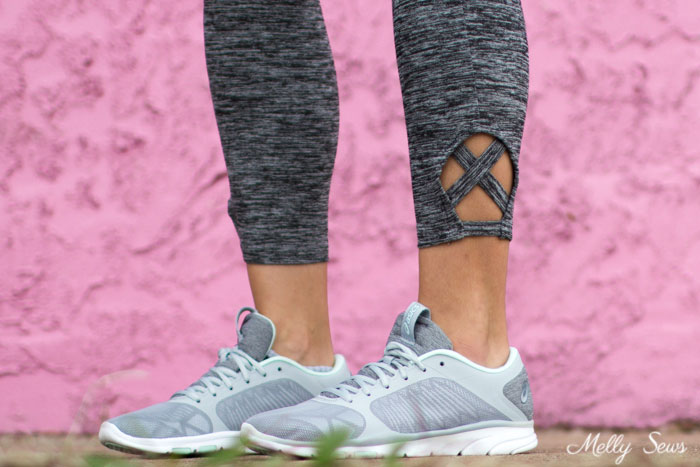
Remember our discussion of fabrics vs fibers? See here if you don’t. Even though spandex fiber makes an appearance in many fabrics, when people refer generically to spandex, they’re generally talking about nylon/spandex or polyester/spandex blends knitted with 4 way stretch. Think about the type of fabric that makes up swimsuits, dance costumes and other form-fitting stretch garments, and that’s the type of fabric we’re talking about sewing today. Other woven fabrics that contain elastane are usually referred to as stretch versions of the normal fabric name. For example cotton and Lycra blended into a denim weave would be called stretch denim.
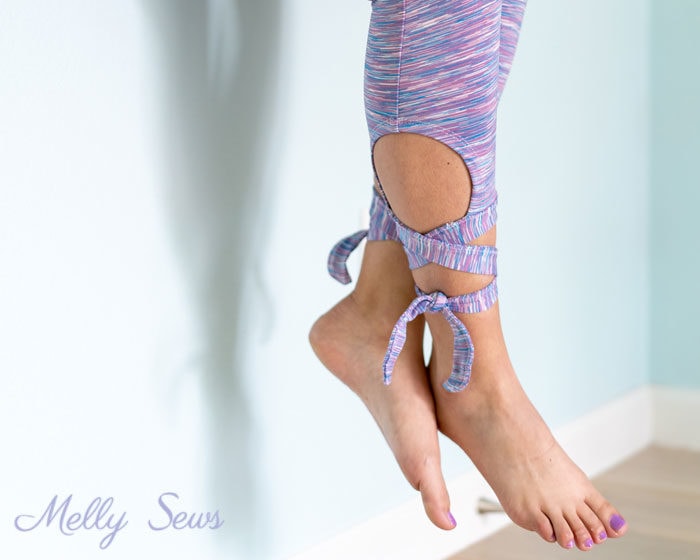
Spandex is used often in athletic wear because of the stretch and recovery properties it has, so the month of athleisure would not be complete without talking about it. In this post about knits I address general tips for sewing stretch fabrics, and those do apply to spandex, but today I’m going to share some additional tips because sometimes it seems like spandex has a mind of its own!

Where to Buy/What to Buy
First, check your pattern – there are probably specific suggestions for fabric type and weight. When looking for elastane fabric for activewear, you’ll likely encounter nylon/spandex blends in lighter and heavier weights, performance Lycra (aka, Coolmax, etc) that may have wicking properties (to pull moisture/sweat away from your body) and polyester/spandex. Cotton or rayon spandex blends are generally lightweight, thinner and not suitable for athletic performance wear, but may be good for t-shirts and tanks. If you’re sewing bike shorts, leggings, yoga pants, etc, I suggest ordering samples to check how densely woven they are. If you can easily see light through the fabric, it’s not going to be squat proof.
Keep in mind that elastane isn’t necessarily the most breathable fabric. The fibers blended with it and the construction both affect breathabilty. That means high spandex content fabrics don’t usually work well for underwear or socks or other times when you want a breathable layer. Keep in mind that unless the fabric description specifically mentions being breathable, wicking, or cool in hot weather, it’s probably not. Yet another reason ordering samples is a good idea.
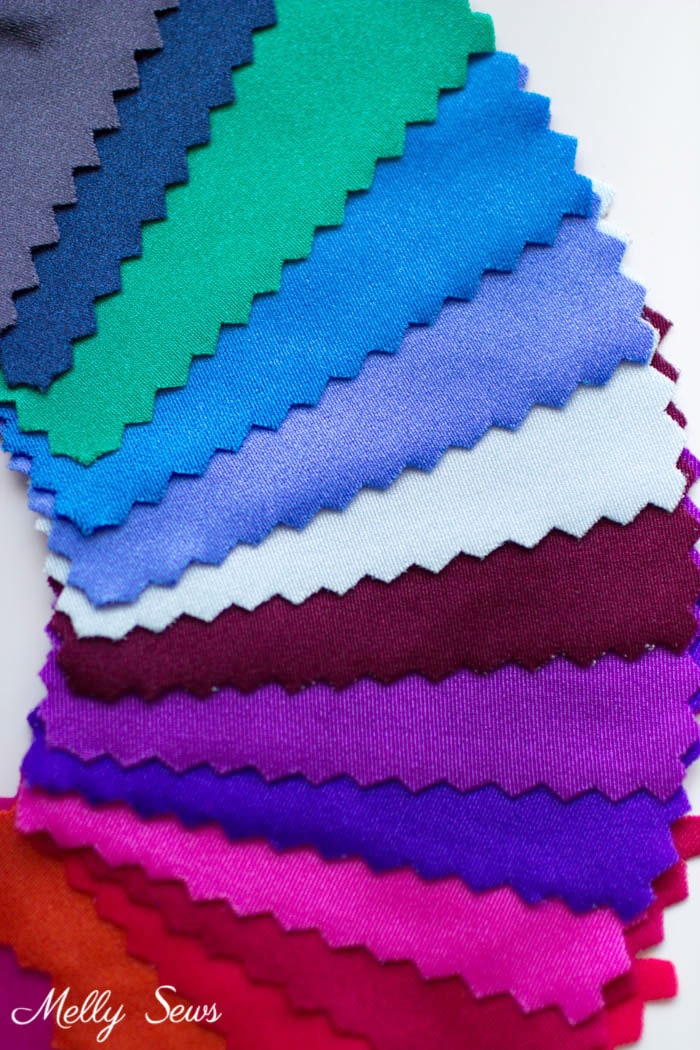
As for where to buy, I like to get mine in person when I shop in Dallas’s warehouse district. I’ve also found lovely spandex at my local Joann (that’s where I got the fabric in the leggings I’m wearing), but that can vary widely and I wouldn’t order it online from them. From Fabric.com I’ve been very pleased with the Pine Crest blends. I also frequently order from Seattle Fabrics, but it’s worth ordering samples first so that you know exactly what you’re getting. And finally, I hear good things about Spandex World, but I haven’t personally ordered from them. They do have more selection of spandex than the other sites I mentioned.
Sewing Spandex
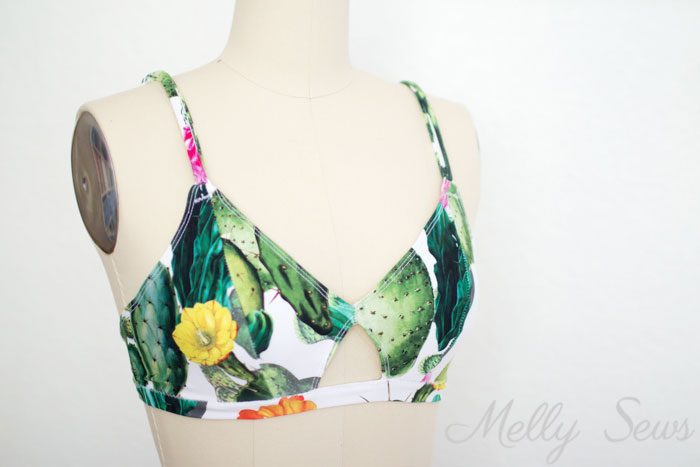
I will also caution, that in all my decades of sewing, nothing has made my want to pull my hair out as badly as metallic spandex fabric. So if you’re new to spandex, approach shiny stretch metallics with extreme caution as many, many machines hate them. My best tip if the shiny sucked you in is to stabilize the seams with tissue paper under the fabric and go very slowly. Even then you may have issues. One time I had to throw out all the conventional wisdom and use a microtex sharp needle to sew it. If nothing else is working that might be worth a try.
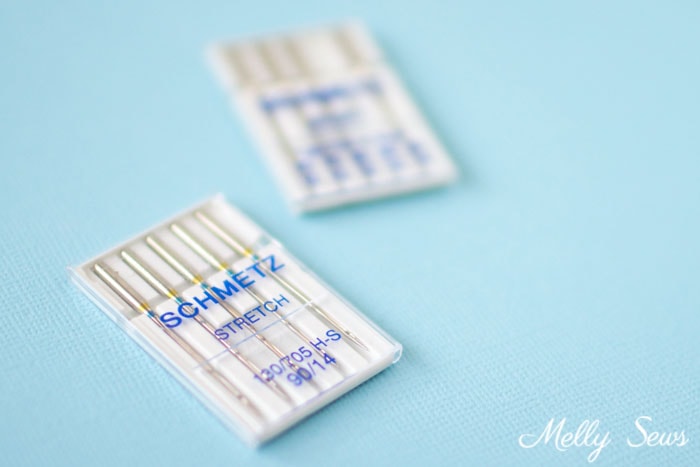
Needles
You can try a universal needle, but in general you’re going to need a ball point needle, and things can get confusing here because you may see needles labeled ball point, stretch, and jersey. So which one do you get?
Both the stretch and jersey needles are ball point. If you’re dealing with the Schmetz brand the package will probably say Jersey and Ball Point somewhere. These Jersey/Ballpoint needles may work with your machine and spandex, but Schmetz recommends the Stretch needle for this application, which has a deeper scarf (the indentation above the needle eye where the bobbin thread is grabbed) and shorter eye. The shorter eye can be problematic with thicker threads, so if you’re experiencing skipped stitches with a stretch needle, try a thinner polyester thread or a larger needle.
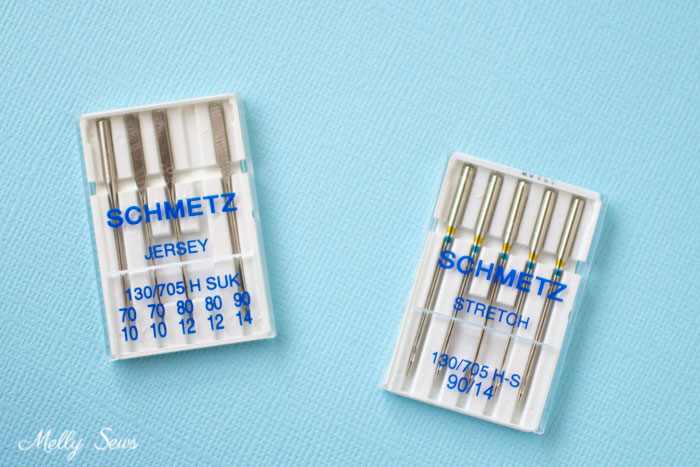
Needle sizes are by number and a larger number = a larger needle. Thread weights are by number, and bigger numbers = thinner thread. As an example, Coats and Clark Dual XP All Purpose thread is 35 weight, so if that is a problem in your machine you might try a 60 weight thread.
Further reading on threads and needles:
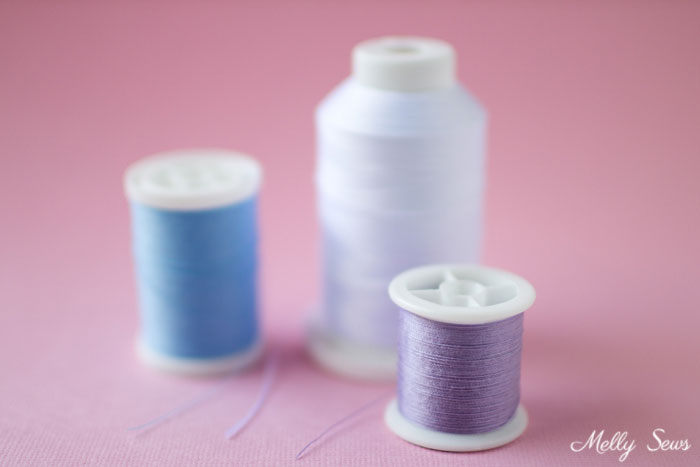
Thread
As mentioned above, polyester thread is a good general pick for sewing spandex. If using a serger or cover stitch machine, you may also want to consider wooly nylon thread, especially for the loopers.
Stitch Selection
This post on stretch stitches covers several different types of stitches. Because the fabric/machine/needle/thread combination can be tricky to get right with spandex, it’s important to sew several sample stitches first to see how they’ll perform. Try different stitches as well as adjusting the stitch width and length to find one you like. Once you think you have the right stitch on your fabric, also make sure to double your fabric and sew again (as you will be on seams) because sometimes that double layer of spandex can make your machine behave differently.
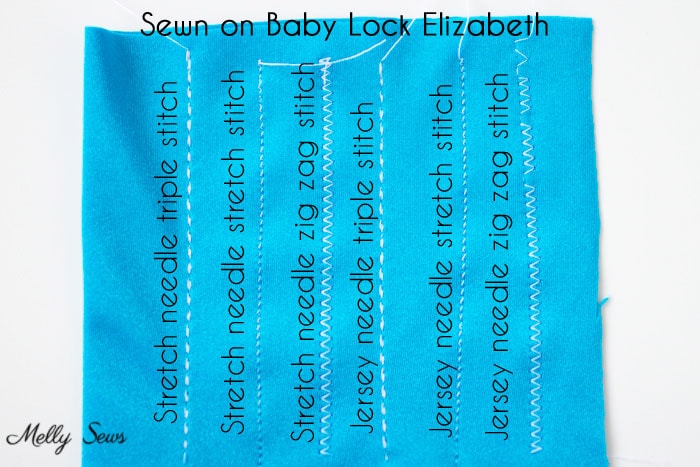
Below you can see some samples sewn on two layers of nylon spandex with my modern Baby Lock Elizabeth machine and using Coats and Clark Dual XP General Purpose thread. The jersey needle worked fine for everything except the zig zag stitch, where you can see skipped stitches. That didn’t happen with the stretch needle.
I’ve also heard that vintage machines can’t use stretch needles/won’t sew spandex. So I did a few tests for myself. I have a Singer 503 that is pushing 60 years old that I used for this test. The reason I did not use my even older machine is because it only does a straight stitch and I don’t know why you’d want to sew a straight stitch on such stretchy fabric – it’s a recipe for popped stitches. I did sew a straight stitch for my sample just for purposes of comparison, but I would not use it in an actual garment.
Just like my modern machine, both needles worked, but the jersey needle caused skipped stitches with the zig zag stitch.
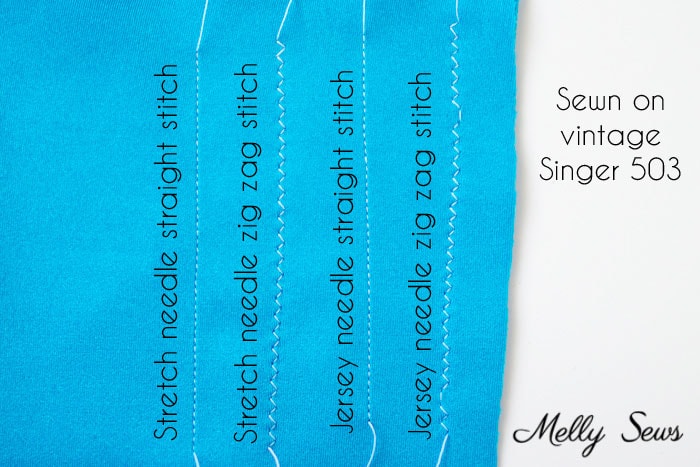
Care
Spandex is a generally durable fabric and hard to stain, but it loses its elasticity and recovery with heat. So to maintain the stretchiness of your fabric, don’t wash in hot water, dry on hot temperatures, or press with a very hot iron. If you do need to press, using a pressing cloth and a low temperature setting is best. Luckily, spandex is hard to wrinkle. If you’ve used your elastane to make sportswear that gets a lot of perspiration while you wear it, odors can be an issue. In those cases, rinsing your clothing right after taking it off if you can’t wash immediately can help. Detergents formulated specifically to remove sweat, lotions and body oils from active wear can also be helpful, as can a vinegar rinse.
I sometimes get questions about whether spandex fabrics can be dyed. Obviously there is dyeing of the yarns in the fabric construction process, but home dyeing polyester spandex can have unpredictable results. For that reason, if at all possible, I recommend finding fabric the color you want to begin with.


Susan
I recently purchased Eloflex thread (coats) it is stretchable thread that you use in the bobbin (that you don’t have to hand wind) and on top. I just finished a pair of leggings used a reg. stitch and it was fantastic. No SERGER!! Give it try
Tammy
God bless you. Lol.
Kate
I recently got 18 yards of matte silver lycra from Fabric Wholesale Direct and was pleased with the product and the quality / price ratio. I sewed a 4 thread mock safety using Wooly Nylon on the loopers and had excellent results.
Fun Shimabukuro
Thank you Kelly and all the commentators!! I just read this post in March 2019 and want to say I learned a lot from all you fellow sewists!! I have purchased from Spandexworld online and they have a wonderful selection. I got a beautiful leopard shiny stretch fabric from them – and every time I wear an outfit (I made several) made with this fabric I got many complements. Note: They didn’t pay me to say nice things about their products.
If you ever go to New York City – make sure to check out their store. Also I have tried the Eloflex thread but only in the machine bobbin. Works great and certainly provides the stretch needed but wooly nylon on a serger is still the best way to sew these tricky stretchy fabrics.
Emily
Excellent post and tips. My machine definitely prefers stretch needles.
Jacky F
Lots of good info here!
I sew a lot of nylon lycra and have always used the stretch needles but I’ve found another that works even better and lasts far longer too! It’s the HAx1SP ‘superstretch’ needle. Both Organ and Schmetz make them, they’re chrome coated and last far longer as a result. There is more info from Schmetz below. They’re in the 130/705H needle system so they fit & perform just as well in ordinary sewing machines as they do in those sergers/coverstitchers that don’t specify ELx serger needles.
https://www.google.com/url?sa=t&rct=j&q=&esrc=s&source=web&cd=3&cad=rja&uact=8&ved=0ahUKEwi4yviP4dDaAhWLaVAKHVfuCeIQFgg0MAI&url=http%3A%2F%2Fwww.schmetz.com%2Fcache%2Fdl-SCHMETZ_0216_Super-Stretch-Needle_HAx1-SP_GB-pdf-a4560d4356ee4767c5aaaf984568f53c.pdf&usg=AOvVaw2ojeJmXiGeTodLwCWcxsY-
Chantal Lapointe
Thank you very much for this article. I am in the midst of a swimsuit sewing blitz and the information in this article answered my many questions. At last, a comprehensive article on what to do in order to prevent skipped stitches.
Carmen
Great info. Thank you so much for sharing your knowledge!????
Shawn
That was great! Well illustrated, concise, thank you.
Margaret
Thank you. Great info. Will definitely use these tips when next sewing spandex.
Kelly
I have never cried in frustration before when sewing a garment. I was feeling utterly defeated and quite down. UNTIL I read the sentence ‘I will also caution, in all my decades of sewing, nothing has made me want to tear my hair out as badly as metallic spandex fabric.’ Thankyou, thankyou, thankyou for writing that sentence! I thought I was a complete nutter and when I’m onto using my THIRD sewing machine and getting the same crappy result (trying to do buttonholes) I was about to call a therapist and tell them to come and get me. The relief I feel is unbelievable and tomorrow I’m going to march into my local fabric store and try a larger sized stretch needle. God I hope it works……..😬 Thankyou for this article and thankyou for saving this girls sanity. ❤️
Moe Brown
I just found this article after literally crying in frustration after trying two different machines to sew metallic spandex. Many of us appear to be in this same boat. So grateful to have found this and other people with the same problem.
Lucy Hanks
I have just found this article looking for information regarding thread for sewing spandex; unfortunately I have yet to begin sewing the luminous green metallic spandex unitard frog costume and was trepidatious about what I might encounter, after one stint many years ago sewing a slinky satin/metallic finish jersey to have it ladder at every seam; so wishing myself luck for tomorrow’s sewing expedition and hope I don’t disappoint for children’s book-day.
Dianne
I have run up against a problem when trying to hem some yoga pants. Can’t get the machine to make stitches! Tried both zigzag stretch stitch and straight to no avail. Thought at first there was something wrong with my machine, but when I put some other cotton scrap fabric through, it sewed properly. I have a ball point needle (14/90) in place and even put on my walking foot (which always works well with stretch fabrics). However still no luck! Do you think getting a specific “stretch” needle may help resolve this problem? Or could it be a thread problem?? Thank you for any help you may give me.